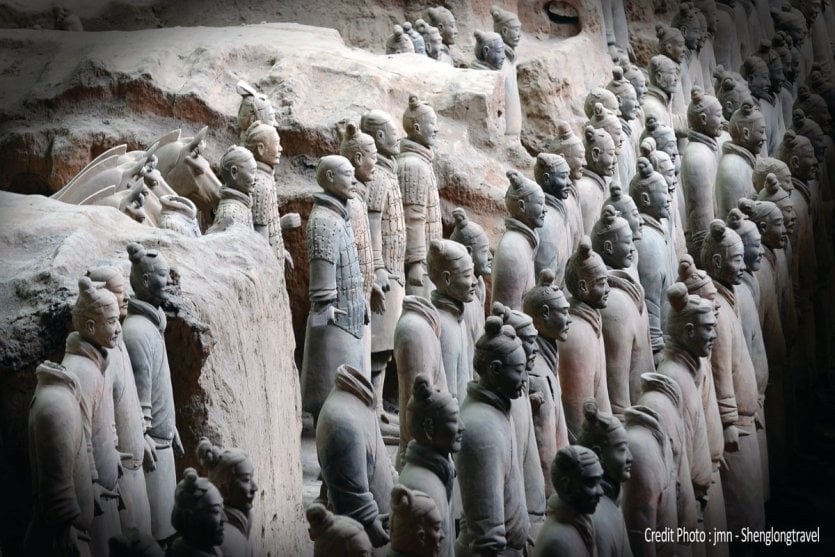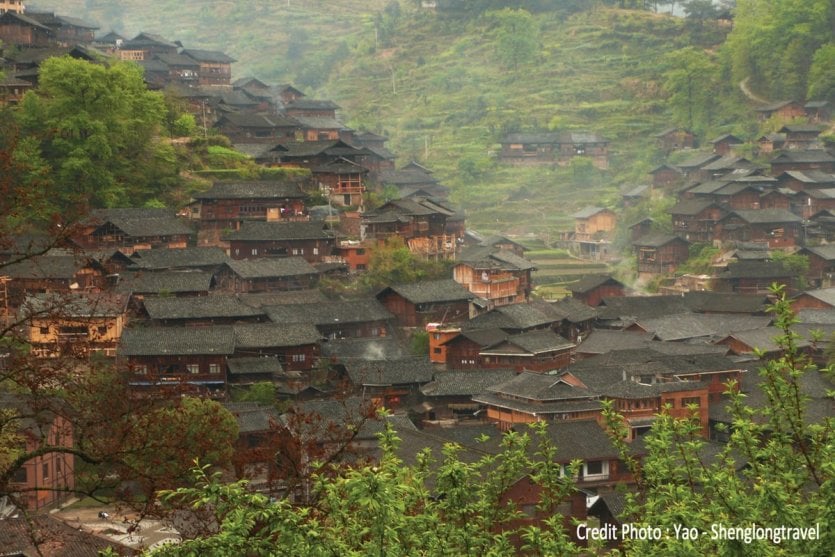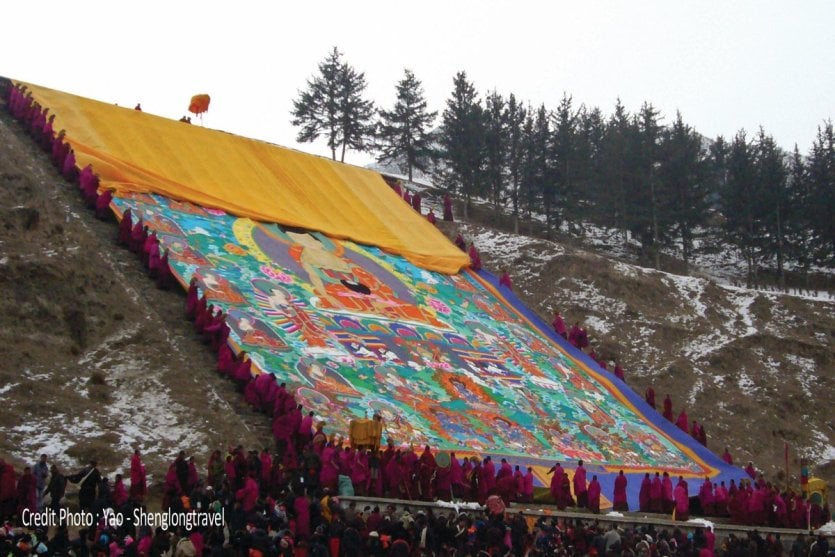
Beyond its image as a great economic power that Modern China is becoming, China conceals many hidden treasures from its millenary history. The Middle Kingdom has the largest number of sites classified by UNESCO. These exceptional places that we will present to you are all fascinating and easily accessible. More than ever, China is a destination that offers a guaranteed change of scenery; whether by train, road or air, you will travel safely in this country with an immemorial culture by your own means or in the company of customised travel specialists in China, such as the ShengLong Travel agency
N°10 - Beijing - The Great Wall of China

The Great Wall of China or "Changcheng" stretches from the Shanhai Pass "Shanhai Guan" on the east coast to the Jiayu Pass "Jiayu Guan" in the Gobi Desert. The construction of the "original" wall began under the Qin Dynasty, two centuries before our era. The Great Wall of China is one of the most important sites with its 6,700 kilometres of stones and history. It is the backbone of the country. A timeless and cultural symbol, it required the work of nearly 1/5th of the Chinese population during its construction. The most popular sections are easily accessible from Beijing but nothing can replace a day trip on the walls of Jinshanlin.
N°9 - Datong - Yungang Caves

In the 5th century, an unpublished imperial commission was at the origin of the Yungang Caves. The Yungang Caves or "Cloud Ridge Caves" are the most fabulous example of Buddhist rock art in China. Over nearly one kilometre, the site consists of 252 carved niches and nearly 51,000 statues. The Indian influence in the style used for the monumental statues of Sakyamuni reinforces an impression of majesty and elegance. The Yungang Caves will show you some of China's most precious and refined monumental works.
N°8 - Xi'an - The armies of Terracotta Soldiers

East of the capital of Shanxi province, Emperor Qin Shi Huang's army of terracotta soldiers is one of the most famous archaeological discoveries in the world. Forgotten for more than two millennia, these legions of life-size soldiers are another example of the richness of the funerary art of the highly controversial but eminently popular first emperor who succeeded in unifying China. More than soldiers, it is in fact a whole people that has been reproduced to accompany the emperor on his last journey. Visiting the site of the Terracotta Army is a unique experience to learn about the civilization of ancient China.
N°7 - Taiyuan - The Jinci Temple

Only a few kilometres from Taiyuan you can discover a unique architectural ensemble, the ancient Buddhist temple of Jinci, built from the 10th century onwards. Consisting of a multitude of buildings built at different times and according to different techniques, the Temple of Jinci is the setting for the oldest wooden buildings in Shanxi province. After crossing the bridge of the meeting of the Immortals, the temple of the sacred goddess, protected by its eight dragons rolled up on the first row of columns, will show you 42 terracotta statues from the time of the Song dynasty. A pearl of Chinese architecture, the temple of Jinci is full of legends, details and ancestral traditions.
N°6 - Sichuan - Jiuzhaiguo Park

It is at the northern end of Sichuan, near the border with Gansu province that you will discover this natural park, which was listed as a UNESCO World Heritage Site in 1992 and in 1997 the park was inventoried in the World Network of Biosphere Reserves, considered as the temperate forest with one of the greatest biological diversity in the world. The park of Jiuzhaiguo or the "Valley of the Nine Villages" has the advantage of combining mountains, lakes, waterfalls and virgin forests. The Juizhaiguo Park area is part of the Tibetan regions of northern Sichuan that are accessible without a special permit from Chengdu. According to an ancient Tibetan legend, a Tibetan god who was madly in love with a goddess gave her a mirror as a gift. Troubled, the goddess dropped the mirror, which broke into 118 pieces, forming the emerald or turquoise lakes of Juizhaiguo. The Juizhaiguo Natural Park can be visited on foot on its marked paths or by using the free shuttle service. Along the way, rest areas will allow you to fully enjoy a day trip to the heart of the natural park, considered one of the most beautiful in China.
N°5 - Leshan - The Great Buddha

DAFO or "Great Buddha", with its 71 m height, is the largest Buddha in the world since those of Bamiyan in Afghanistan were destroyed. Sculpted on a cliffside above the confluence of the Dadu River, its origin dates back to the 8th century AD. At the initiative of the Haitong Buddhist monk, the Giant Buddha of Leshan was sculpted to provide protection for mariners and fishermen sailing on the river. 90 years were necessary for its construction and for the wish of the Haitong monk to come true. The great Buddha of Leshan offers himself from different perspectives. You will not fail to take carefully the small staircase that will lead you along the face of the Great Buddha to his feet to approach his fantastic dimensions. The site, inscribed on UNESCO's World Heritage List since 1996, is simply one of the most spectacular in Asia.
N°4 - Turfan - Pearl of the Silk Road

Turfan or Turpan is an oasis city in the Xinjiang region located in a geological depression below sea level. The main oasis on the northern branch of the Silk Road, it is adorned with a shimmering green during the short rainy season. Although in the middle of a mineral landscape, Turfan is nicknamed the brilliant pearl of the Silk Road. An important Buddhist centre, it gradually transformed under the influence of caravanserai flows to convert to Islam in the 14th century, at the time of the Great Tamerlan. Earthly citadel battling with the winds of the Taklamakan desert, the walls of the ancient Uighur capitals, the elegance of the Minaret Emin are raw jewels on the Silk Road where you can discover the charm and authenticity of another China

N°3 - Guizhou - Land of the Dong and Miao

Guizhou is one of the few Chinese provinces that are still unknown on traditional tourist routes. In the heart of an omnipresent nature, Guizhou promises you an explosion of traditional colours and rituals. Its landscapes of hills and rainforests are criss-crossed by noisy streams interspersed with magnificent waterfalls. A mosaic of cultures and ethnicities, 35% of the population of Guizhou's villages is composed of more than 18 different minorities. Here, nature lovers can stroll through the heart of the villages of traditional wooden houses, admire the rice terraces, or even appreciate the diversity of the costumes of the peoples of Guizhou. This deep countryside, still isolated in some places, will welcome you for a human experience, an immersion in the expression of a rural culture in southern China.
N°2 - Xiahe - Labrang Monastery Festival

Accessible to foreign travellers without a special Tibetan permit, the extraordinary monastic complex of Labrang Monastery "Labuleng Si" in the Amdo region is one of the largest Gelupa "Yellow Caps" monasteries in the Tibetan highlands region. For those who wish a first contact with ancestral Tibet, Labrang Monastery is certainly the place where you will feel all the energy of the spirituality of Tibetan Buddhism and the extraordinary richness of its culture. In a magnificent mineral landscape, Labrang Monastery is one of the six most important Tibetan monasteries of the monks in Yellow Bonnets. Founded in 1709 by a former abbot of Deprung Monastery, Labrang Monastery has sheltered up to 4,000 monks. It is still today, a high place of spirituality and an important milestone for a large number of Tibetan pilgrims. This is reflected in the famous Monlan festival known as the "Great Prayer", held a few days after the Tibetan New Year. More than 10,000 pilgrims go there to celebrate spiritual and natural renewal and participate in the Giant Thangka ceremony; 20m x 30m sacred painting on the hill overlooking the monastery. Moaning prayer wheels, Processions of penitents, Sutras chanting religious songs, and traditional dances from the Cham region will transport you to another universe
N°1 - Tibet Hymalayen - Lhasa

Tibet Himalayan or "Land of Snow" is a unique destination in the world. In the shadow of the Himalayan mountain range, a trip to the Himalayan Tibet "Xizang" is always an adventure for Western travellers. The harshness of its climate due to its altitude, the charm of its culture, the beauty of its sites and landscapes only reinforce the magic of this exceptional destination. In the heart of Himalayan Tibet, Lhasa retains its place as the spiritual capital of Tibetan Buddhism. Overlooking the plain and the city of Lhasa, on the hill of Marpori, the Potola Palace "Budalagong" is in fact an extraordinary 13-storey Palace-Fortress. It was once the seat of religious and territorial power in Greater Tibet. Considered one of the world's architectural wonders, it has been on UNESCO's World Heritage List since 1994.


